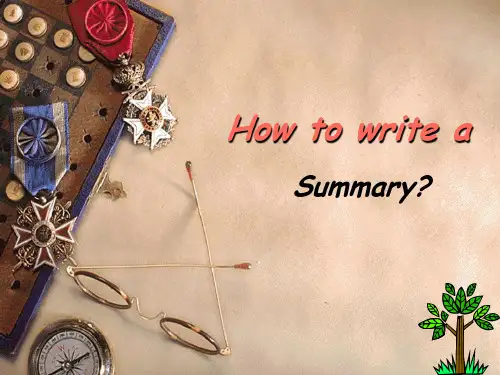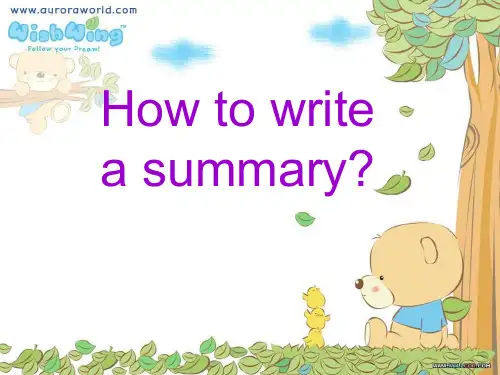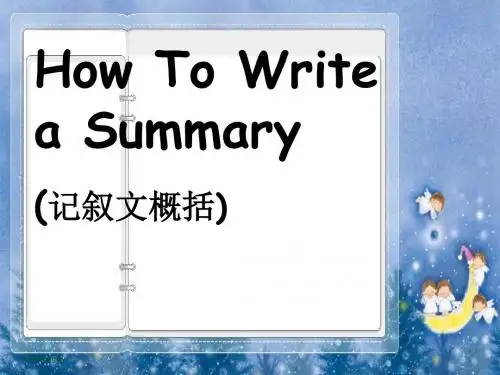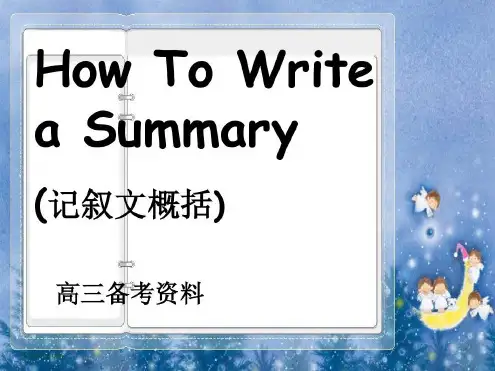How to Write A Summary
- 格式:ppt
- 大小:140.00 KB
- 文档页数:38
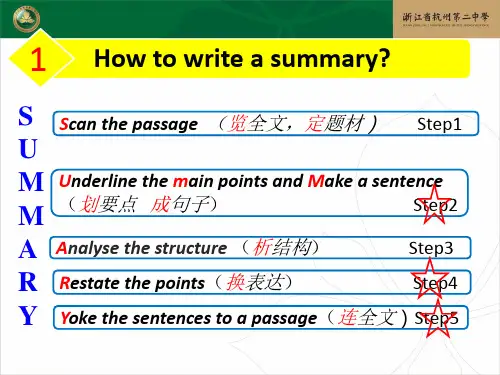
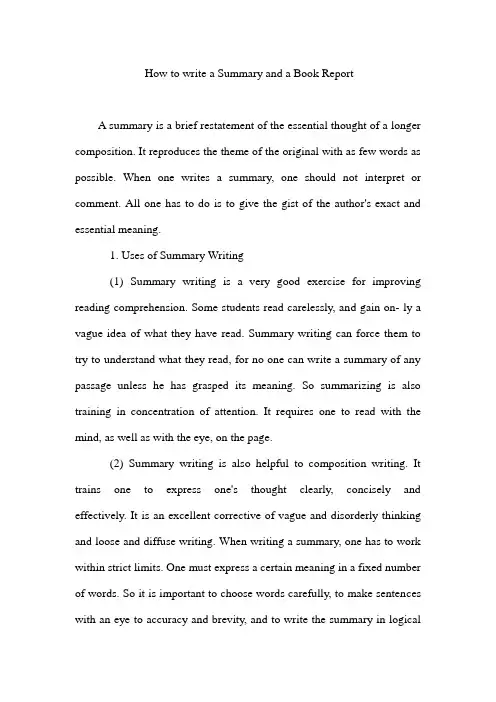
How to write a Summary and a Book ReportA summary is a brief restatement of the essential thought of a longer composition. It reproduces the theme of the original with as few words as possible. When one writes a summary, one should not interpret or comment. All one has to do is to give the gist of the author's exact and essential meaning.1. Uses of Summary Writing(1) Summary writing is a very good exercise for improving reading comprehension. Some students read carelessly, and gain on- ly a vague idea of what they have read. Summary writing can force them to try to understand what they read, for no one can write a summary of any passage unless he has grasped its meaning. So summarizing is also training in concentration of attention. It requires one to read with the mind, as well as with the eye, on the page.(2) Summary writing is also helpful to composition writing. It trains one to express one's thought clearly, concisely and effectively. It is an excellent corrective of vague and disorderly thinking and loose and diffuse writing. When writing a summary, one has to work within strict limits. One must express a certain meaning in a fixed number of words. So it is important to choose words carefully, to make sentences with an eye to accuracy and brevity, and to write the summary in logicalorder.(3) Summary writing has practical uses. The ability to grasp quickly and accurately what is read, or heard, and to reproduce it in a clear and concise way is of great value to' people of many professions. For scientists, businessmen, lawyers, and government officials this ability is not only important, but necessary.2. Procedure(1) Reading.A. First read the passage through carefully to get the gist of it. If reading it once is not sufficient to give you a clear understanding of it, read it over again. The more you read it, the more familiar to you will be its subject, and what is said about the subject.B. Give a title to your summary. Think of some word, phrase or short sentence that will sum up briefly the main idea of the pas- sage. Sometimes what is called a topic sentence may be used. The topic sentence may be found at the beginning or at the end of the passage. To find a suitable title Will help you to define what exactly the subject, or main theme, of the passage is.C. You should now be in a position to decide what parts of the passage are essential and what parts are comparatively unimportant and can be omitted without much loss.D. Jot down in brief notes the main points---the subject, the title,and the details which you consider essential or important.(2) Writing.A. A summary should usually be about one-third to one-fourth as long as the original passage. So count the number of words in the passage and divide it by three. You may use fewer words than the number prescribed, but in no case may you exceed the limit.B. The summary should be all in your own words. It must not be a patchwork made up of phrases and sentences quoted from the original passage.C. You should follow the logical order of the original passage, if possible (and desirable). Ideas and facts need not be rearranged.D. The summary should be self-contained, that is, it must convey the message of the original fully and clearly, so that your reader need no reference to the original to understand what its main ideas are.E. Summary writing is an exercise in compression. In writing a summary, you may:--Ommit the details. Only the important points should be included in the summary; all the details that explain the main points can be left out.--Reduce the examples. Out of five or six examples given in the original passage one or two may be chosen for the summary; the rest are to be omitted.--Simplify the descriptions. If in the passage there are ten sen-tences describing a person or an object, it will be enough to keep one or two in the summary.--Eliminate all_repetitions. Sometimes a statement is repeated for emphasis. This is not necessary in a summary. Sometimes an idea is repeated in different words. Such a veiled repetition should also be avoided.--Compress wordy sentences and change phrases to words. Here are a few examples:"His courage in battle might without exaggeration be called lion-like."He was very brave in battle."The account the witness gave of the incident made everyone thatheard it laugh."The witness's story was absurd."They acted in a manner that rendered them liable to prosecution."They acted illegally."John fell into the river and, before help could reach him, he sank."John was drowned in the river."He was hard up for money and was being pressed by his creditor."He was in financial difficulties.You may also make phrases do the work of clauses or sentences. Here is an example:Beautiful mountains like Mount Tai, Lushan Mountain, and Yellow Mountain, were visited by only a few people in the past. Today, better wages, holidays with pay, new hotels on those mountains, and better train and bus services, have brought them within reach of many who never thought of visiting them ten years ago.These two sentences may be abridged in this way:Beautiful mountains like Mount Tai, once visited by only a few people, are today accessible to many, thanks to better wages, paid holi- days, new hotels and better communication.--Use general words instead of specific words. Here is an example: “She brought home several Chinese and English novels, a few copies of Time and Newsweek, and some textbooks. She intended to read all of them during the winter vacation.”This may be turned into:She brought home a lot of books and magazines to read during the va- cation.--Use the shortest possible transitions. For example, but, then, thus, yet, and for, can be used in place of longer transitions like at the same time, on the other hand, etc. Often the semi-colon can take the place of a transitional word or phrase.--Put the main points of a dialogue in indirect speech. This is advisable because indirect speech can be made very brief while it isdifficult to abridge dialogues.(3) Revision.Revise your draft. Campare it carefully with the original to see that you have included all the important points. If it is too long, further compress it by omitting unnecessary words and phrases or by remodelling sentences: Correct all mistakes in spelling, grammar and idiom, and see that it is properly punctuated. Make the language simple and direct.Read the following examples and try to find out the methods used in' them.读书报告读书报告共分为三种类型,摘要式报告,简评式读书报告,和书评式读书报告。
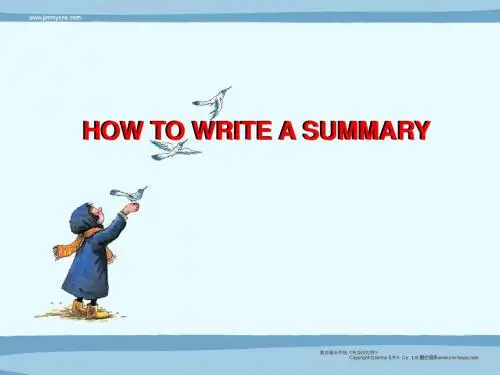
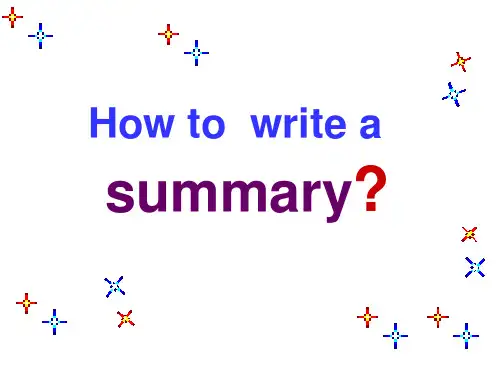
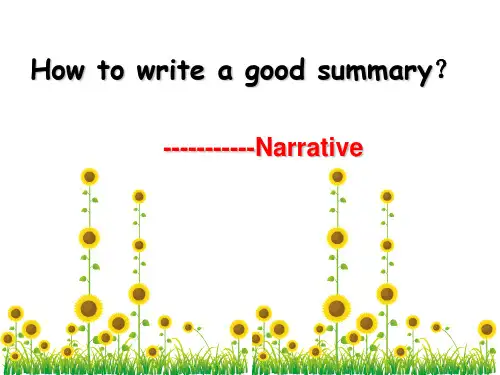
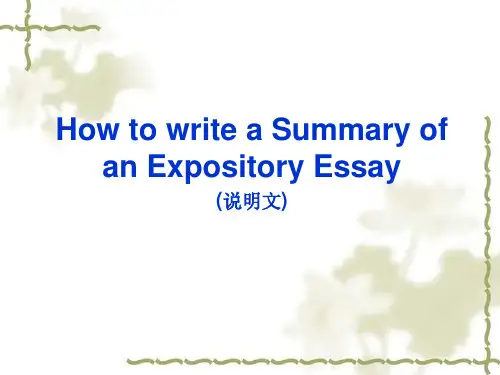
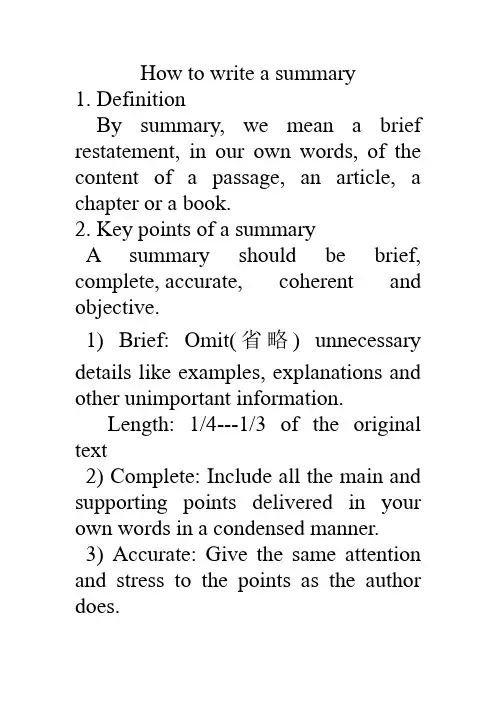
How to write a summary1. DefinitionBy summary, we mean a brief restatement, in our own words, of the content of a passage, an article, a chapter or a book.2. Key points of a summaryA summary should be brief, complete, accurate, coherent and objective.1) Brief: Omit(省略) unnecessary details like examples, explanations and other unimportant information.Length: 1/4---1/3 of the original text2) Complete: Include all the main and supporting points delivered in your own words in a condensed manner.3) Accurate: Give the same attention and stress to the points as the author does.4) Coherent: Rather than an outline listed as key words and phrases, a summary is a paragraph with necessary transitions and function structures to make it flow.e.g. first, in the first part, in the introductory partSecond, next, in the second partThen, afterwards, after that, in addition to that, also, furthermorefinally, at last, in the end, as a conclusion, on the whole, in a word, to sum up, last but not least, as a result, so 5) Objective: Do not include your own ideas or emotions on the topic. The summary should only reflect the content of the original passage.3. Steps to write a summary1)Read the material and underline all the important points and all the important evidence. For example, you can look for all the topicsentences.2)List the main idea of the whole piece, the main supporting ideas, and the main evidence for each idea. Be careful to use your own words rather than copying or just rearranging. Do not include minor details.3)Be ready to write the summary. Start with a sentence that botha) Identifies the writer and the piece of writing, for example by giving the writer’s name, the title of the piece and where/when it appeared.andb) Gives the main idea.4)Organize the main and related supporting points in a logical order with necessary transitions to achieve coherence. Change the order if necessary, so that the main idea comes first and is followed by the supporting ideas and evidence. Omitany repetitions.5)If the original uses “I” replace this with the writer’s actual surname,“the writer”, or “he/she”. If the original uses “you”, substitute(用…代替)“people” or “they”.6)If you must use the words of the author, cite (引用) them.7)Don’t put your own opinions, ideas, or interpretations(诠释) into the summary. The purpose of writing a summary is to accurately represent what the author wanted to say.8)Proofread(find and correct mistakes) for grammatical, spelling and punctuation mistakes.。
